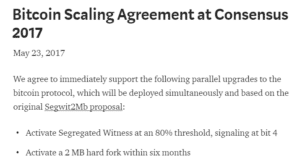Scaling Bitcoin: The New York Agreement Explained
Last Updated: 1st November 2018
The New York Agreement is a scaling agreement that was brokered by Barry Silbert’s Digital Currency Group, and is designed to tackle the contentious issue of Bitcoin’s scalability. The agreement contains 58 signatories, ranging from exchange providers to mining companies in the Bitcoin community.
Bitcoin Scalability
The concern with Bitcoin’s scalability is that it will not be able to handle a growing number of transactions on its network. As is stands, the Bitcoin protocol limits the size of each block to 1MB. This is problematic because not all transactions can fit into a 1MB block; user’s often face higher transaction times and fees, as a 1MB block cannot contain the rising number of transactions. In effect, users on the network are paying higher transaction fees to ‘cut the line’ and get their transactions confirmed quicker. There is wide acceptance of the need to upgrade Bitcoin’s protocol, however, there is fierce disagreement about the best way to do it. In general, proposals to scale Bitcoin are either to increase the size of each block, or to scale using Segregated Witness (SegWit). The New York Agreement is a comprise between these two sides of the debate, those who prefer to scale by increasing the block size, and those by SegWit. Argument over Bitcoin’s scaling also resulted in the creation of a new cryptocurrency, Bitcoin Cash, which was created in opposition to the SegWit solution. Instead of using SegWit, Bitcoin Cash attempts to tackle the problem of Bitcoin scaling by increasing the block size limit from 1MB to 8MB.
The terms of the New York Agreement are as follows:
The first part of the agreement has already been fulfilled, with SegWit activating on the 1st of August. The next stage is now the 2MB hard fork, also commonly known as SegWit2x, is scheduled to occur in mid-November 2017. More specifically, the hard fork is scheduled to activate at block height 494,784. Estimated time for the Segwit2x hard fork can be found here.





